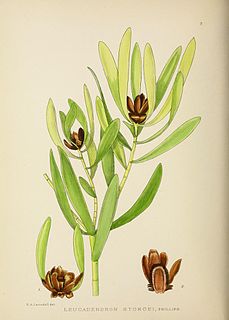
The International Union for Conservation of Nature (IUCN) Red List of Threatened Species, founded in 1964, is the world's most comprehensive inventory of the global conservation status of biological species. It uses a set of precise criteria to evaluate the extinction risk of thousands of species and subspecies. These criteria are relevant to all species and all regions of the world. With its strong scientific base, the IUCN Red List is recognized as the most authoritative guide to the status of biological diversity. A series of Regional Red Lists are produced by countries or organizations, which assess the risk of extinction to species within a political management unit.

Tetranychus urticae is a species of plant-feeding mite generally considered to be a pest. It is the most widely known member of the family Tetranychidae or spider mites. Its genome was fully sequenced in 2011, and was the first genome sequence from any chelicerate.

Withania somnifera, known commonly as ashwagandha, Indian ginseng, poison gooseberry, or winter cherry, is an annual evergreen shrub in the Solanaceae or nightshade family that grows in India, the Middle East, and parts of Africa. Several other species in the genus Withania are morphologically similar. Although thought to be useful as a medicinal herb in Ayurveda and sold in many countries as a dietary supplement, there is insufficient scientific evidence that it is safe or effective for treating any disease.

Mellissia was formerly a monotypic genus in the family Solanaceae with the single species, Mellissia begoniifolia, , endemic to the island of Saint Helena. It was named by Joseph Dalton Hooker in honour of John Charles Melliss, a 19th-century engineer and amateur naturalist who worked on Saint Helena. The plant is now known correctly as Withania begoniifolia (Roxb.) Hunz. & Barboza, the genus Mellissia having been subsumed in the genus Withania.

Alternaria is a genus of Deuteromycetes fungi. Alternaria species are known as major plant pathogens. They are also common allergens in humans, growing indoors and causing hay fever or hypersensitivity reactions that sometimes lead to asthma. They are present in the human mycobiome and readily cause opportunistic infections in immunocompromised people such as AIDS patients.

Zieria is a genus of plants in the family, Rutaceae. About sixty species have been formally described, all of which are endemic to Australia except for one species which is found in New Caledonia. They occur in all Australian states except Western Australia but the genus is under review and a number of species are yet to be described or the description published. Zierias are similar to the better known genus Boronia but can be distinguished by the number of stamens in the flowers. The name Zieria honours the Polish botanist John Zier.
Libocedrus chevalieri is a species of conifer in the cypress family, Cupressaceae. It is endemic to New Caledonia, occurring in three small, isolated populations on low mountain summits at 650–1,620 m altitude in cloud forest scrub on serpentine soils. It is threatened by habitat loss.

Bertiera is a genus of flowering plants in the family Rubiaceae. It comprises 57 species with most known from tropical Africa, five known from various Indian Ocean islands and five found in the tropics of the Americas.
Hemandradenia chevalieri is a species of plant in the Connaraceae family. It is found in Ivory Coast and Ghana. It is threatened by habitat loss.
Withania adunensis is a species of plant in the family Solanaceae. It is endemic to Yemen. Its natural habitats are subtropical or tropical dry forests and subtropical or tropical dry shrubland.

Withania is a genus of flowering plants in the nightshade family, Solanaceae, with 23 species that are native to parts of North Africa, western Asia, south Asia, southern Europe, the Mediterranean, and the Canary Islands.
Withania riebeckii is a species of plant in the family Solanaceae. It is endemic to Yemen. Its natural habitats are subtropical or tropical dry forests and subtropical or tropical dry shrubland.
Zanthoxylum chevalieri is a species of plant in the family Rutaceae. It is endemic to Ghana. It is threatened by habitat loss.
Zieria chevalieri is a species of plant in the family Rutaceae. It is endemic to New Caledonia.
Acridocarpus monodii is a species of plant in the Malpighiaceae family. It is endemic to central Mali, where it is limited to the Bandiagara Escarpment region, in the ecotone of the West Sudanian Savanna and Sahelian Acacia Savanna.

Leucadendron microcephalum is a dioecious, single-stemmed, South African shrub belonging to the family Proteaceae, endemic to the Western Cape and growing from sea level to 1200 m. It is one of some 200 species in the genus, all confined to South Africa.
Withania coagulans is a plant in the Solanaceae or nightshade family, native to Afghanistan, Pakistan and the Indian subcontinent. Within the genus Withania, W. somnifera (Ashwagandha) and W. coagulans are economically significant, and are cultivated in several regions for their use in Ayurveda. It is claimed to help control diabetes. The berries contain a rennet-like protease that can be used to clot milk for cheese production. The plant is prone to leaf spot disease caused by Alternaria alternata.
Quercus chevalieri is an uncommon species of tree in the family Fagaceae and the "ring-cupped oak" sub-genus. It has been found in Vietnam and also in southern China, in the Provinces of Guangdong, Guangxi, and Yunnan.

Cycas chevalieri is a species of cycad in central Vietnam, including in Nghe An Province. It may also occur in Laos.
Droogmansia chevalieri is a plant in the legume family Fabaceae, native to West Africa.










